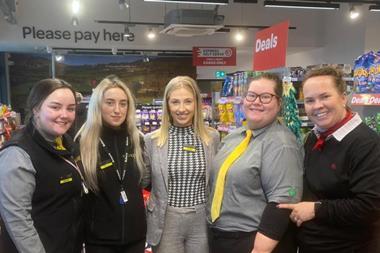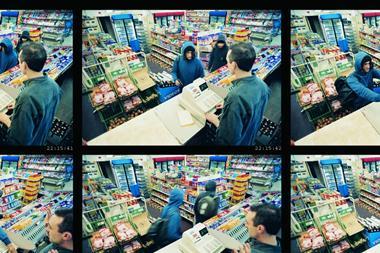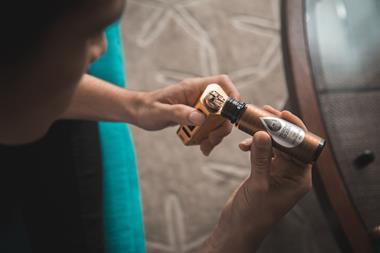Saki Gahfoor
Nisa Extra, Ashington, Northumberland
Saki opened a 6,500sq ft Nisa Extra in a shopping parade in Ashington in April, adding to the family’s community-based c-store in nearby Gateshead. The new store makes a virtue of its ample space.
Guy Warner
Warners Budgens, Gloucestershire
A two-times winner of the Convenience Retailer of the Year Award, Guy knows what it takes to run a successful store. Guy has a number of Budgens stores in the Cotswolds and is always ready to embrace new ideas.
Malcolm Crump
Spar Compton, Wolverhampton
Along with his brother Gordon, Malcolm Crump runs the community hub that is Spar Compton in Wolverhampton and both have more than 40 years of retail experience that they are always willing to share.
Tim Farmer
Eurospar Broomhill, Sheffield
A Best Large Store finalist at this year’s Convenience Retail Awards, Tim makes sure his flagship Eurospar in Sheffield meets every possible demand from his shoppers thaks to a large range and excellent customer service.
Do you have many secondary display units (SDUs), and how effective are they?
Saki: We have quite a large store in Ashington so have about 30 altogether, including clip strips. They’re spread across the categories as we always try to have something for everyone. We have our own displays as well as the regular Nisa promotions which last three weeks.
Guy: Our stores are littered with them in a good way, of course. They’re proven as sales drivers and sales of products on these units have often seen double- or even triple-digit sales growth.
Malcolm: We have a fair few SDUs in the store and find them very effective, especially with driving sales of new products that can sometimes get lost on the shelves. They also add to the theatre of the store. If nothing ever changed then it would get a bit boring.
Tim: There’s about 20 in our shop, which seems to be the perfect amount. They are fantastic for making customers aware of new products. They’re also great for price promotions as they let people know that even though we’re a convenience store, we can compete with supermarkets on price. A lot of our displays are determined by head office, but we do have some say in the size and we can create our own as well.
Do suppliers have realistic expectations about what an SDU can achieve?
Saki: Suppliers will sometimes over-estimate how well a product will do, which is disappointing, but at least 80% of the time it will meet their expectations.
Guy: The reps have their job to do so I don’t worry about their expectations. You have to be careful which lines you decide to have on SDUs as every manufacturer will want their product displayed and you only have so much space available. You have to consider which ones would drive the category or the store forward, rather than just that particular line. The last thing you want is some parasitic unit that will just take up space and not add anything to the store.
Malcolm: Some expect a lot from us and others are just grateful that we display their products. Generally, if they’ve gone to the trouble of designing a SDU or dump bin, they have an expectation that it will sell well. All we can do is display them and do our best. I would say that we usually meet their expectations, especially if the product has been advertised on TV or in magazines.
Tim: Mostly they’re fine and don’t set the bar too high, but some of them are a bit over the top and don’t realise that what works in one store may not work in others.
Saki: Generally, they are very accommodating as they want the unit to be displayed in your store. Suppliers are usually willing to come in and put the unit together for us and stock it up. We’ve built up a good relationship with them from our Gateshead store so they know us and what can be achieved.
Guy: They’re usually happy to come in and create something. However, quite often we’ll create seasonal displays ourselves that will be cross-category. Halloween and Christmas are prime examples of this. We’ll have everything that a person could need for a particular event in one display. It seems to work better this way for us, rather than spreading it out around the store.
Malcolm: Definitely. We get offers of SDUs quite regularly and can’t always use all of them. It works both ways as well if we want a display unit for a seasonal event, then more often than not suppliers are happy to help.
Tim: I’ve found that they’re not as helpful as they have been in the past. Perhaps this is because they’re more focused on the multiples rather than the convenience sector.
Saki: Masterfoods, Pepsico and Unilever are usually great to work with. They’re willing to put in the time with retailers and listen to what they have to say. I would like to see more SDUs in the alcohol category, especially for wines as they are under-represented in this area.
Guy: Cadbury is quite proactive and has a great choice of off-shelf displays that cater for most sized stores, and will quite often create something bespoke. Last Christmas Diageo had a great spirits display which not only drove sales of its brands, but helped the category as well since we had more space on the shelf for other spirits. It was an example of a supplier coming up with an innovative approach to SDUs that benefited everyone.
Malcolm: Confectionery is a competitive category for SDUs; they’re quite innovative. There is often a new or limited-edition product in the confectionery category so SDUs are a great way to highlight them. The wine category is falling behind, I believe, and magazines need to find a way to have better secondary units. The only one who gets it right in magazines is the Radio Times at Christmas when they have an SDU, which is great because we sell hundreds then.
Tim: Cadbury and Mars are very helpful and are always coming to us with great ideas. Beers, wines and spirits could be doing better.
What style of SDU best suits your store?
Saki: For me, bigger is better! I have a lot of space in my Ashington store so I love large displays, although I realise that a lot of other stores would prefer smaller units that don’t take up much space. We have some smaller ones as well, such as the Walkers clip strips which have been doing quite well recently. We put them beside the chillers.
Guy: I’m a big fan of clip strips. They take up so little space yet drive impulse sales. With strips you can have a selection of crisps or confectionery smartly displayed in the alcohol section without taking up space from that category. And any purchase made from a clip strip is usually additional, which is what retailers want from a secondary display. We do have some larger display units, but not so many that they clutter up the store.
Malcolm: I’m not a huge fan of parasite units that take away from the products behind. With an SDU you want to drive additional sales, not cover something up and just replace one sale with another. I prefer big units that add to the overall theatre of the store.
Tim: We can afford to dedicate a lot of space to SDUs, but we try not to have ones that are so big that they block the aisles. There are also some clip strips located around the store.
Saki: We’re more likely to move a SDU to another location in the store if it’s not doing well, rather than remove it altogether. I don’t believe that there’s a magic formula for them, or if there is we haven’t discovered it yet. Sometimes a product that we never expected to do well in a certain location has thrived and sold really well.
Guy: Most displays usually last two to four weeks here and we’ve rarely had to remove a product that wasn’t selling well. The only time something went really wrong was when we had a display of Royal Wedding items. It was a case of the wrong products at the wrong price, and when most of it was left over after the wedding we ended up giving it away!
Malcolm: We’re quite ruthless when it comes to SDUs and will get rid of them if there isn’t a great response.
Tim: Our promotional displays usually last about three weeks and we do have flexibility on products that aren’t selling. We’ll usually move them to another part of the store and replace them with something that we know will sell rather than remove it altogether.
Saki: We have a diverse customer base so it’s important to make sure we have display units with a wide range of products.
Guy: It’s important to consider what will suit your area and customer base when deciding. Obviously, you want a product with good margins, but you want it to complement your store.
Malcolm: We know what our customers like and we’ll make sure that’s reflected in the secondary units we have. We get sent loads every week, but we can’t use them all. If a new product comes in, more often than not we’ll display it as it’s annoying if a product has been on TV and we don’t have it.
Tim: Most of them are organised by head office - our sales are filtered back and they’re good at tailoring promotions to suit a particular store. For the ones we create ourselves, we look at what is selling well and go from there.
Saki: Find the right balance between plenty of offers and cluttering your store. You don’t want to disrupt or annoy your customers by having every aisle full and impossible to pass through easily.
Guy: Look at what will add to the store overall rather than simply driving sales of a particular product. Know your customers and decide what they might like to see on display. There’s no point in just taking an SDU that will waste space and not drive sales.
Malcolm: It’s vital to cherry pick the ones you’ll see the most benefit from. You have to assess what provides the best margins without cannibalising sales.
Tim: Don’t be afraid to try something new. There have been products which I thought would have failed miserably but which have done really well. You have to look beyond your preferences and try to think about what your customers would like. n




























No comments yet